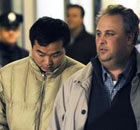Society
Cao's tomb among top discoveries of 2009
By Lin Shujuan (China Daily)
Updated: 2010-01-14 07:57
 |
Large Medium Small |
Authorities yesterday announced a last-minute decision to include the recent discovery of Cao Cao's mausoleum in the list of China's six major archeological findings of 2009.
The discovery of the tomb on Dec 27 sparked a debate among Chinese citizens over the authenticity of the evidence recovered from the ancient structure, buried under the ground in a remote village of Henan province.
Details of the discovery were presented at the Chinese Academy of Social Sciences (CASS) Forum yesterday.
| ||||
Wang Wei, director of the institute, said the list had to be changed to accommodate the discovery of Cao's tomb, as it is "academically very important".
"Regardless of what people think or what the debate is, the tomb is the most major discovery linked to the Wei Dynasty (AD 220 to 265)," Wang said. "It holds the link to China's history, especially the ancient burial culture."
Wang said the institute had already prepared its top six list when news of the tomb's discovery arrived.
The institute sent a team of 12 experts to the excavation site to study the tomb on Monday, Wang said. He denied media reports that the team was to make the evidence linking the tomb to the ancient warlord public yesterday.
"We will launch a seminar tomorrow morning for eight experts to prepare a detailed case study of the discovery," Wang said yesterday.
"We hope when we reveal the study the public can learn more about the science behind archeology and have a comprehensive view about the discovery," he said.












